Sensing Light with LEDs: Performance Evaluation for IoT Applications
Abstract
:1. Introduction
1.1. LED as Optical Receiver
1.2. Related Works
2. Light and Color Detection
3. Results and Discussions
3.1. Light Detection with RGB LED
3.2. Semiconductor Measurements
4. Conclusions
Acknowledgments
Author Contributions
Conflicts of Interest
Abbreviations
| IoT | Internet of Things |
| VLC | Visible Light Communication |
| OOK | On Off Keying |
| VPPM | Variable Pulse Width Modulation |
| CSK | Color Shift Keying |
| PC | Phosphor Converted |
| RC | Resonant Cavity |
| STFT | Short-Time Fourier Transform |
| COM | Common |
References
- Rajagopal, S.; Roberts, R.D.; Lim, S.K. IEEE 802.15.7 visible light communication: modulation schemes and dimming support. IEEE Commun. Mag. 2012, 50, 72–82. [Google Scholar] [CrossRef]
- IEEE. IEEE Standard for Local and Metropolitan Area Networks–Part 15.7: Short-Range Wireless Optical Communication Using Visible Light; IEEE Standard 802.15.7; IEEE: Piscataway, NJ, USA, 2011. [Google Scholar]
- Davis, J.; Hsieh, Y.H.; Lee, H.C. Humans perceive flicker artifacts at 500 Hz. Sci. Rep. 2015, 5, 7861. [Google Scholar] [CrossRef] [PubMed]
- Monteiro, E.; Hranilovic, S. Design and implementation of color-shift keying for visible light communications. J. Lightw. Technol. 2014, 32, 2053–2060. [Google Scholar] [CrossRef]
- Luna-Rivera, J.M.; Suarez-Rodriguez, C.; Guerra, V.; Perez-Jimenez, R.; Rabadan-Borges, J.; Rufo-Torres, J. Low-complexity colour-shift keying-based visible light communications system. IET Optoelectron. 2015, 9, 191–198. [Google Scholar] [CrossRef]
- Kowalczyk, M.; Siuzdak, J. Photo-reception properties of common LEDs. Opto-Electron. Rev. 2017, 25, 222–228. [Google Scholar] [CrossRef]
- Holcomb, M.O.; Mueller-Mach, R.; Mueller, G.O.; Collins, D.; Fletcher, R.M.; Steigerwald, D.A.; Eberle, S.; Lim, Y.K.; Martin, P.S.; Krames, M. The LED lightbulb: Are we there yet? progress and challenges for solid state illumination. In Proceedings of the 2003 CLEO ’03 Conference on Lasers and Electro-Optics, Baltimore, MD, USA, 6 June 2003. [Google Scholar]
- Loiselle, R.; Butler, J.; Brady, G.; Walton, M.; Henze, N. LED Lighting for Oil and Gas Facilities. IEEE Trans. Ind. Appl. 2015, 51, 1369–1374. [Google Scholar] [CrossRef]
- Medina, C.; Zambrano, M.; Navarro, K. Led based visible light communication: Technology, applications and challenges-a survey. Int. J. Adv. Eng. Technol. 2015, 8, 482. [Google Scholar]
- Schmid, S.; Corbellini, G.; Mangold, S.; Gross, T.R. Continuous synchronization for LED-to-LED visible light communication networks. In Proceedings of the 2014 3rd International Workshop in Optical Wireless Communications (IWOW), Funchal, Portugal, 17 September 2014; pp. 45–49. [Google Scholar]
- Li, S.; Huang, B.; Xu, Z. Full Duplex MIMO VLC Using Trichromatic LEDs as Transmitters and Receivers. arXiv, 2017; arXiv:1708.07103. [Google Scholar]
- Chun, H.; Rajbhandari, S.; Faulkner, G.; Tsonev, D.; Haas, H.; O’Brien, D. Demonstration of a Bi-directional visible light communication with an overall sum-rate of 110 Mb/s using LEDs as emitter and detector. In Proceedings of the 2014 IEEE Photonics Conference (IPC), San Diego, CA, USA, 12–16 October 2014; pp. 132–133. [Google Scholar]
- Li, S.; Pandharipande, A.; Willems, F.M. Two-way visible light communication and illumination with LEDs. IEEE Trans. Commun. 2017, 65, 740–750. [Google Scholar] [CrossRef]
- Dietz, P.; Yerazunis, W.; Leigh, D. Very low-cost sensing and communication using bidirectional LEDs. In Proceedings of the International Conference on Ubiquitous Computing, Innsbruck, Austria, 16–19 September 2003; pp. 175–191. [Google Scholar]
- Kowalczyk, M.; Siuzdak, J. Influence of reverse bias on the LEDs properties used as photo-detectors in VLC systems. In Photonics Applications in Astronomy, Communications, Industry, and High-Energy Physics Experiments 2015; International Society for Optics and Photonics: Bellingham, WA, USA, 2015; Volume 9662, p. 966205. [Google Scholar]
- De Santis, F.; Ferrara, M.; Neitzert, H.C. Optical in situ characterization of isotactic polypropylene crystallization using an LED array in avalanche-photoreceiver mode. IEEE Trans. Instrum. Meas. 2006, 55, 123–127. [Google Scholar] [CrossRef]
- Khan, L.U. Visible light communication: Applications, architecture, standardization and research challenges. Digit. Commun. Netw. 2016, 3, 78–88. [Google Scholar] [CrossRef]
- Giustiniano, D.; Tippenhauer, N.O.; Mangold, S. Low-complexity Visible Light Networking with LED-to-LED communication. In Proceedings of the 2012 IFIP Wireless Days, Dublin, Ireland, 21–23 November 2012; pp. 1–8. [Google Scholar]
- Schmid, S.; Corbellini, G.; Mangold, S.; Gross, T.R. LED-to-LED visible light communication networks. In Proceedings of the fourteenth ACM international symposium on Mobile ad hoc networking and computing, Bangalore, India, 29 July–1 August 2013; pp. 1–10. [Google Scholar]
- Ayyash, M.; Elgala, H.; Khreishah, A.; Jungnickel, V.; Little, T.; Shao, S.; Rahaim, M.; Schulz, D.; Hilt, J.; Freund, R. Coexistence of WiFi and LiFi toward 5G: Concepts, opportunities, and challenges. IEEE Commun. Mag. 2016, 54, 64–71. [Google Scholar] [CrossRef]
- Li, S.; Pandharipande, A. LED-based color sensing and control. IEEE Sens. J. 2015, 15, 6116–6124. [Google Scholar] [CrossRef]
- Kasap, S.O. Principles of Electronic Materials and Devices; McGraw-Hill: New York, NY, USA, 2006; Volume 784. [Google Scholar]
- Miyazaki, E.; Itami, S.; Araki, T. Using a light-emitting diode as a high-speed, wavelength selective photodetector. Rev. Sci. Inst. 1998, 69, 3751–3754. [Google Scholar] [CrossRef]

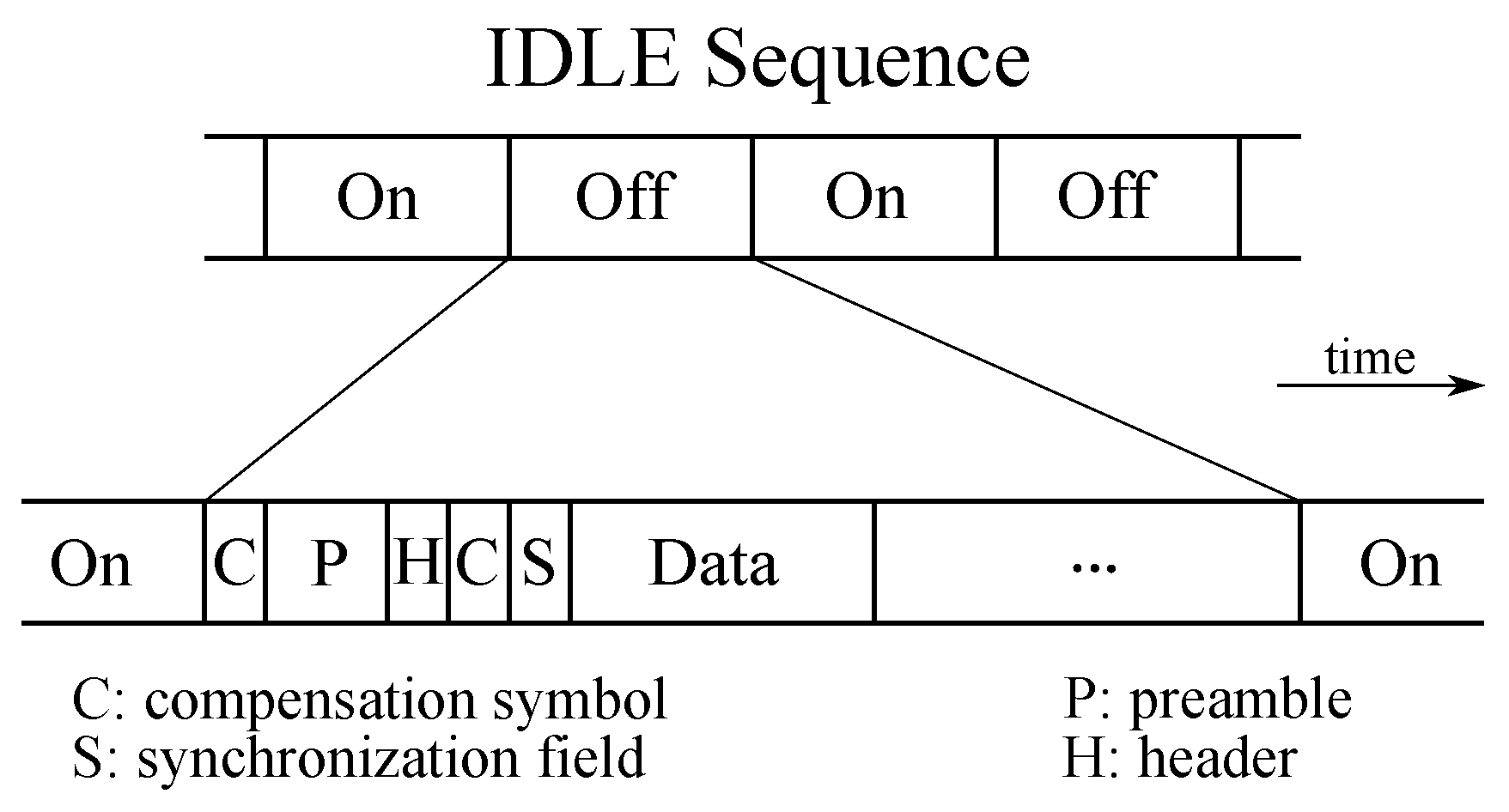
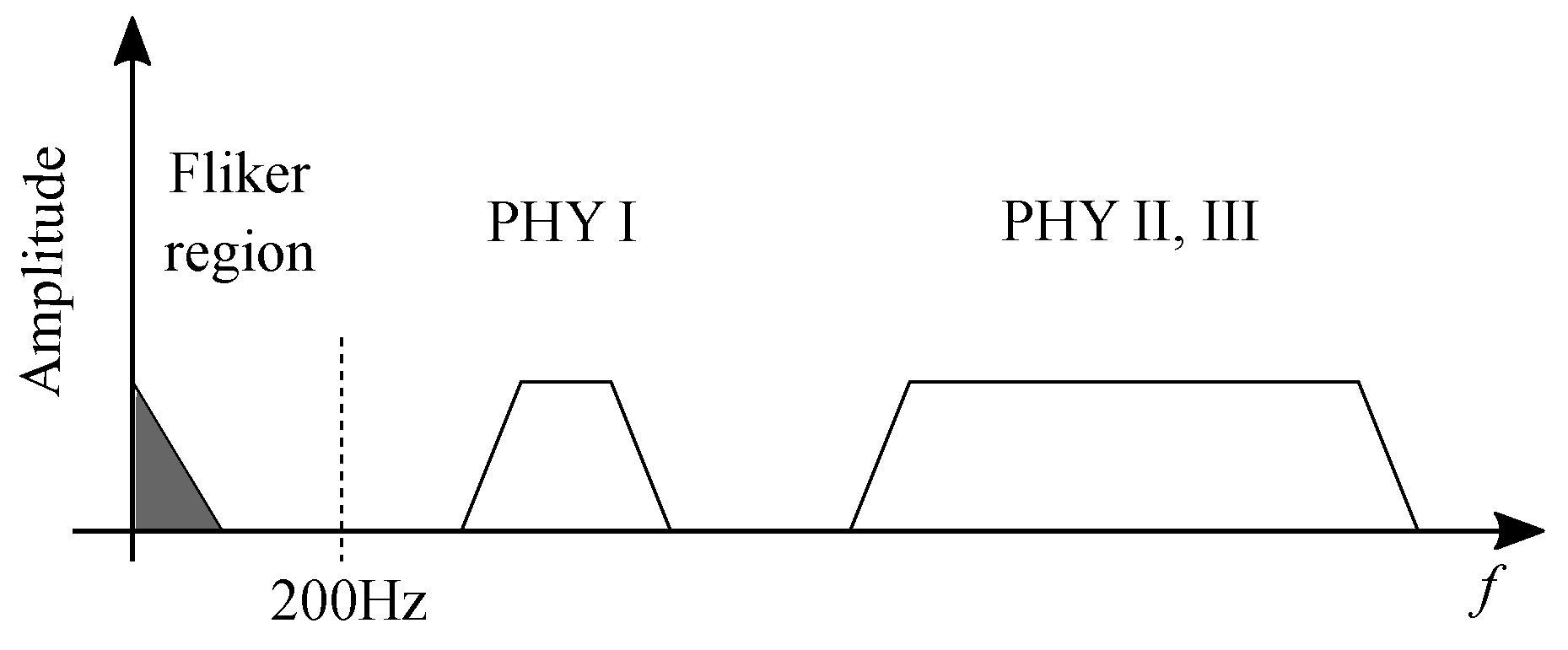


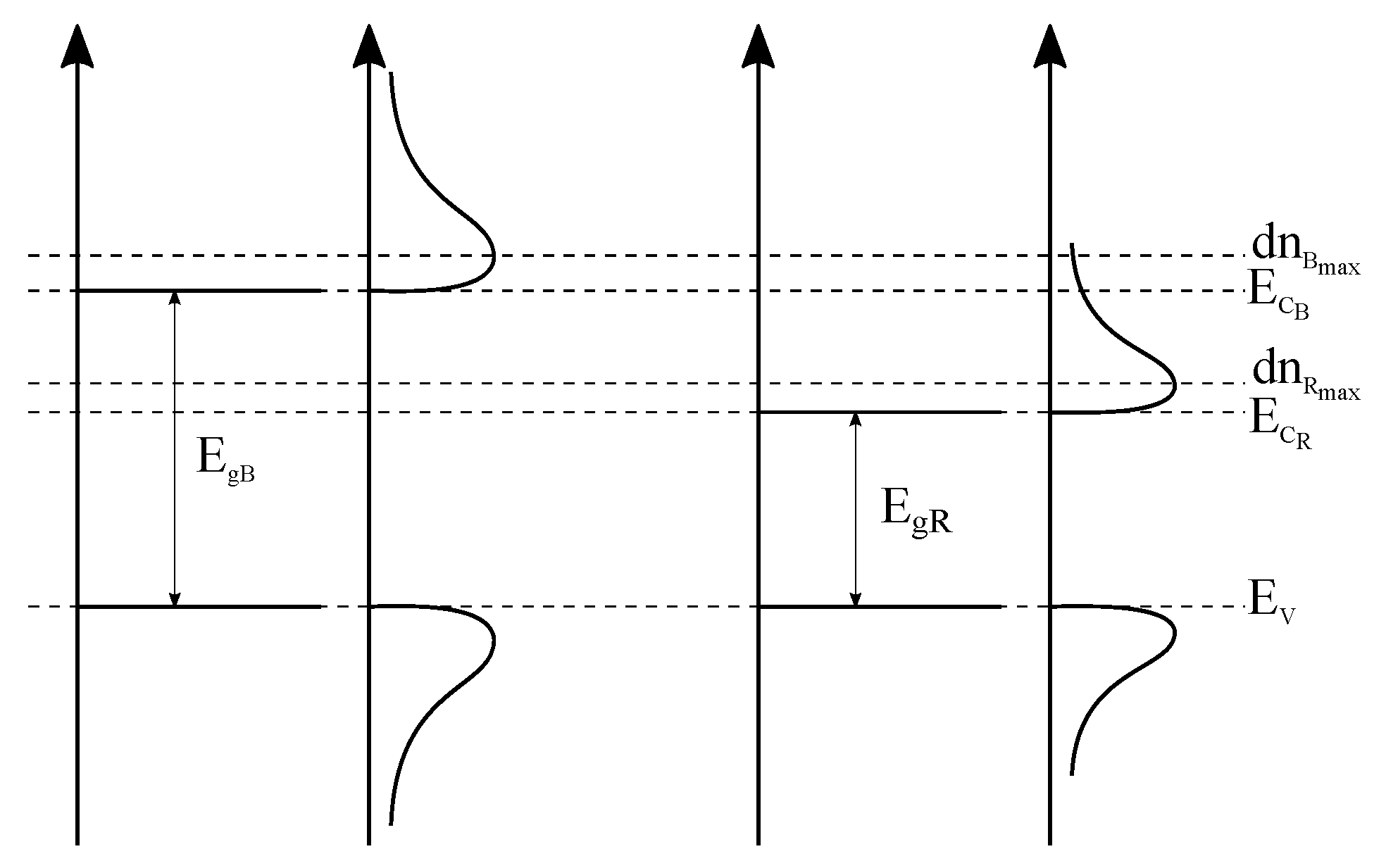




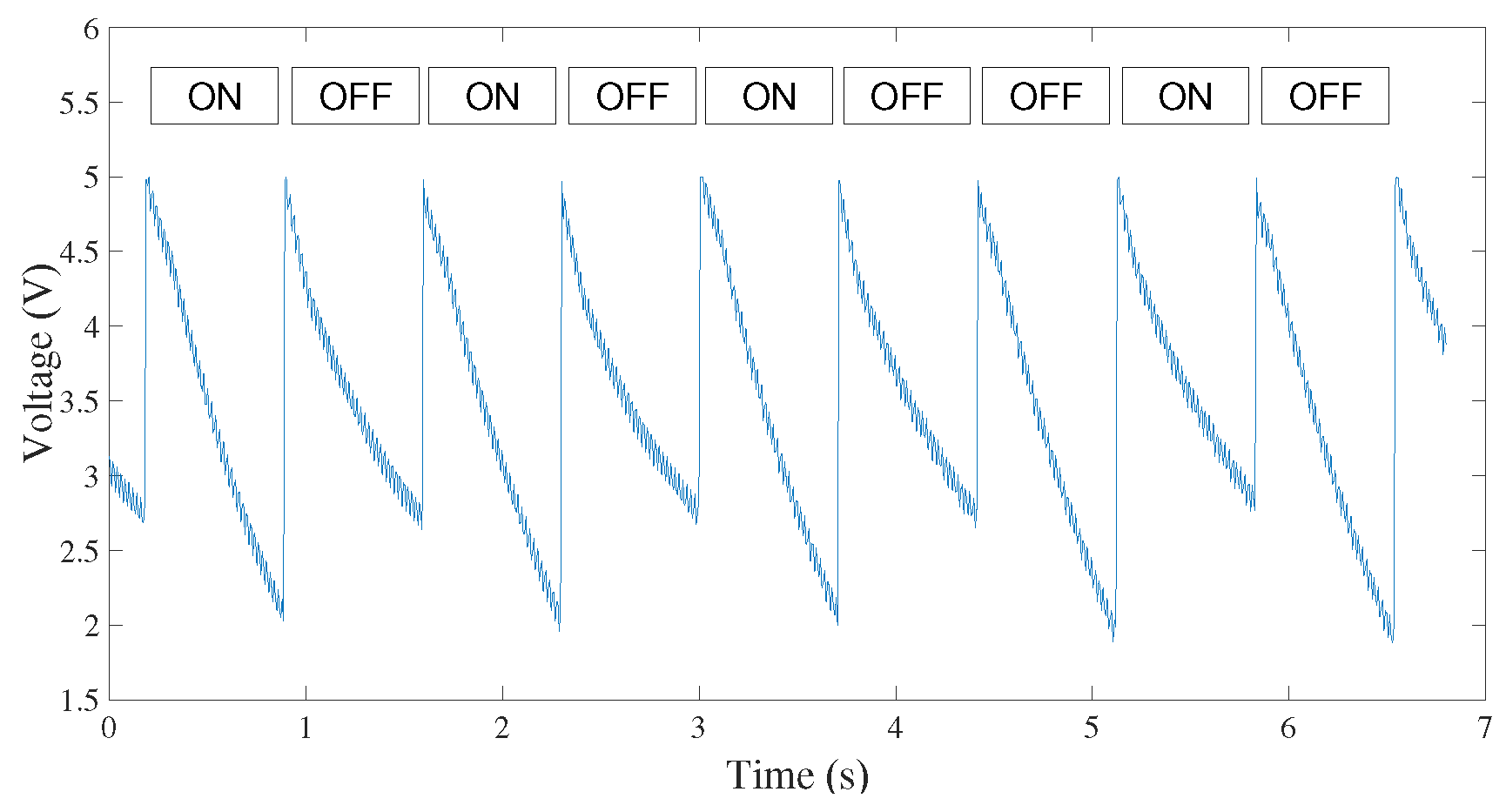
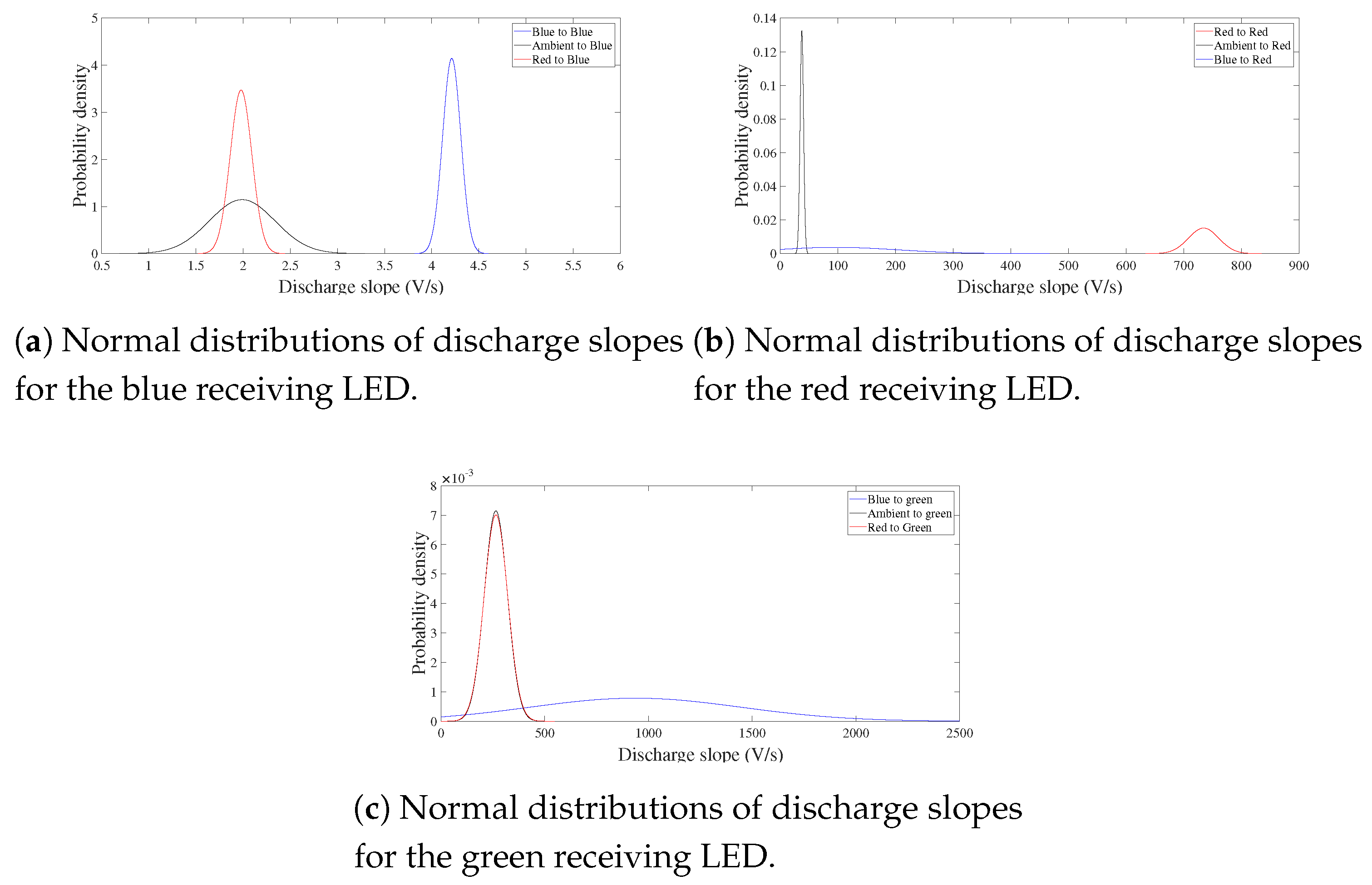
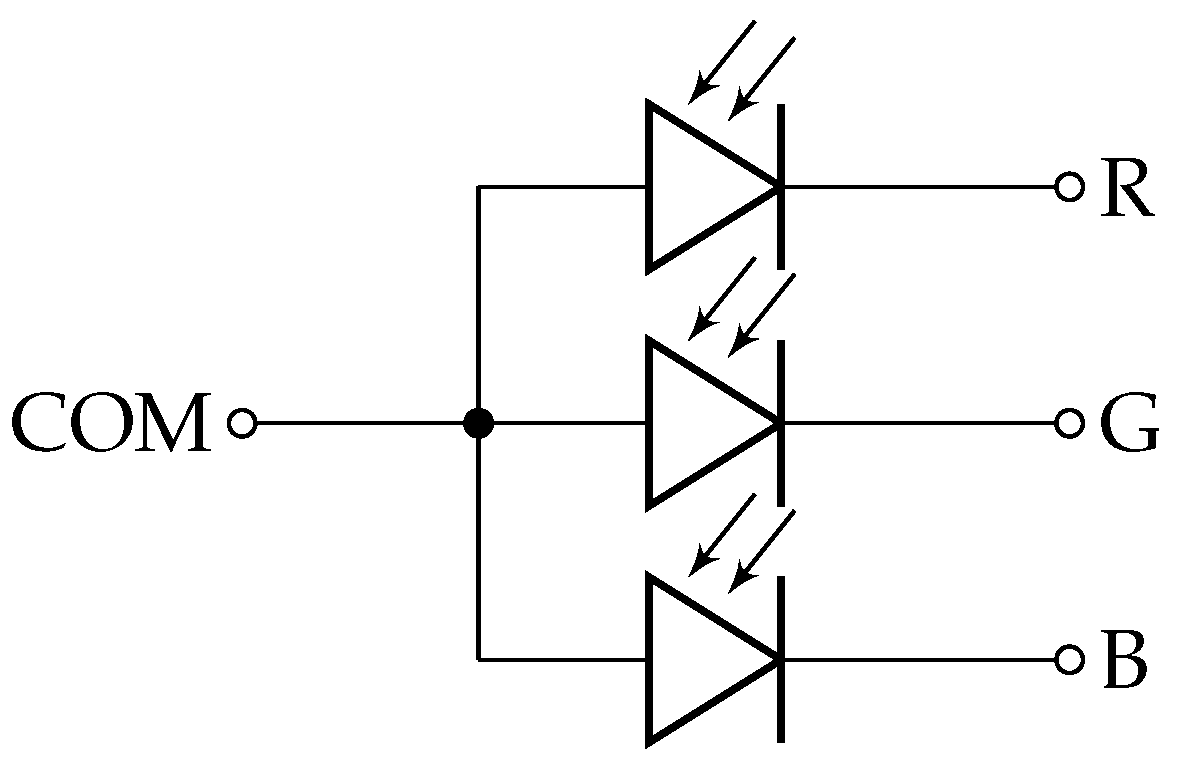



| Model | Manufacturer | Color | C | Material | |||
|---|---|---|---|---|---|---|---|
| L-7104RSC-E | Kingbright | Red | 660 nm | 45 pF | 10 µA | 30 mA | GaAlAs |
| WP710A10SGC | Kingbright | Green | 557 nm | 45 pF | 10 µA | 25 mA | GaP |
| WP710A10VBC/D | Kingbright | Blue | 460 nm | 100 pF | 10 µA | 30 mA | InGaN |
| Optical Receiver | Red | Green | Blue | |
|---|---|---|---|---|
| Light Source | ||||
| Dark | 0.02 | 0.00 | 0.22 | |
| Ambient | 10.00 | 2.56 | 0.31 | |
| 5 mA | Red | 44.55 | 0.01 | 0.33 |
| Green | 18.56 | 52 | 0.33 | |
| Blue | 3.87 | 4.11 | 0.91 | |
| 20 mA | Red | 652.35 | 0.07 | 0.04 |
| Green | 205.56 | 1142 | 0.07 | |
| Blue | 11.62 | 55.14 | 2.93 | |
© 2017 by the authors. Licensee MDPI, Basel, Switzerland. This article is an open access article distributed under the terms and conditions of the Creative Commons Attribution (CC BY) license (http://creativecommons.org/licenses/by/4.0/).
Share and Cite
Incipini, L.; Belli, A.; Palma, L.; Ballicchia, M.; Pierleoni, P. Sensing Light with LEDs: Performance Evaluation for IoT Applications. J. Imaging 2017, 3, 50. https://doi.org/10.3390/jimaging3040050
Incipini L, Belli A, Palma L, Ballicchia M, Pierleoni P. Sensing Light with LEDs: Performance Evaluation for IoT Applications. Journal of Imaging. 2017; 3(4):50. https://doi.org/10.3390/jimaging3040050
Chicago/Turabian StyleIncipini, Lorenzo, Alberto Belli, Lorenzo Palma, Mauro Ballicchia, and Paola Pierleoni. 2017. "Sensing Light with LEDs: Performance Evaluation for IoT Applications" Journal of Imaging 3, no. 4: 50. https://doi.org/10.3390/jimaging3040050







